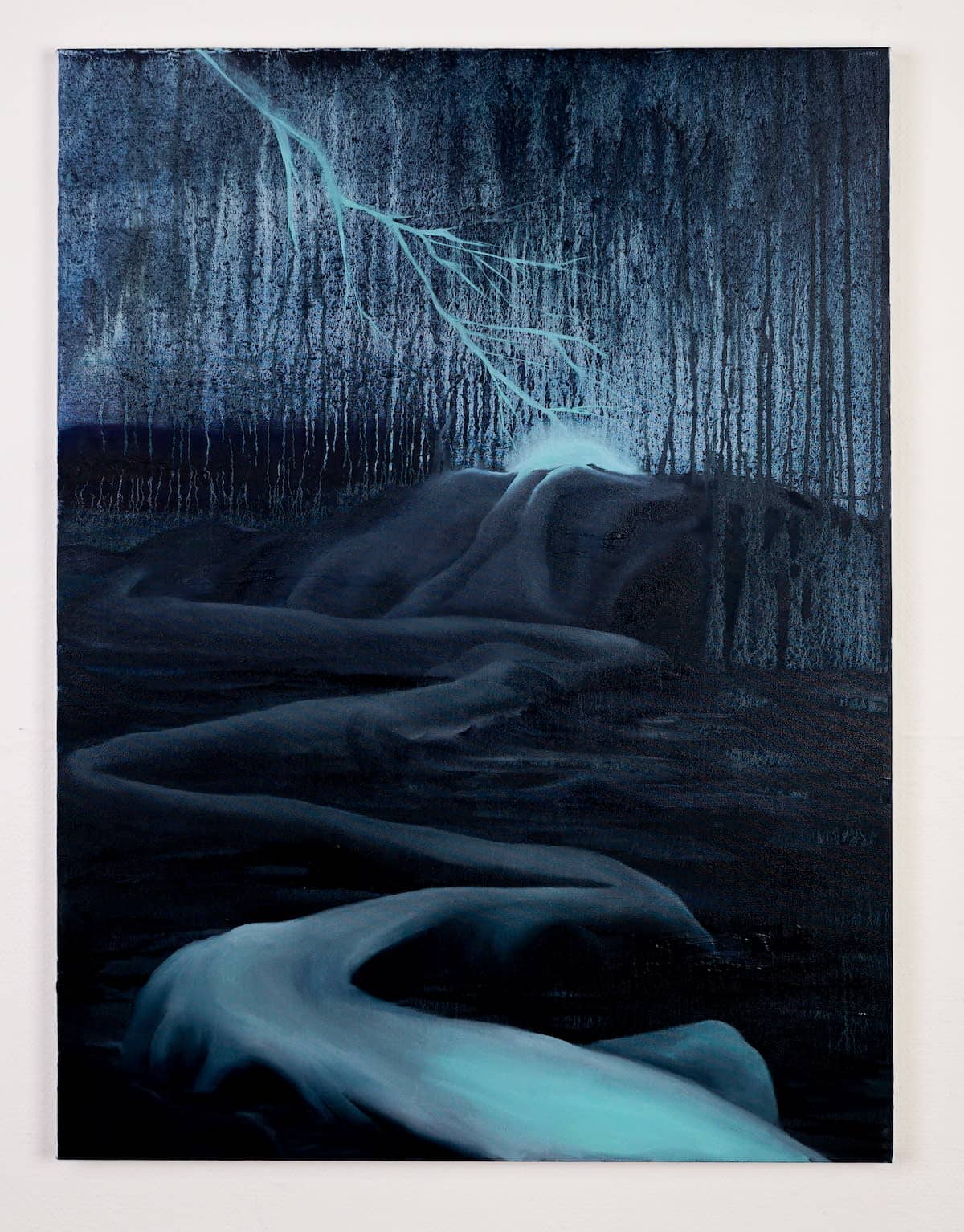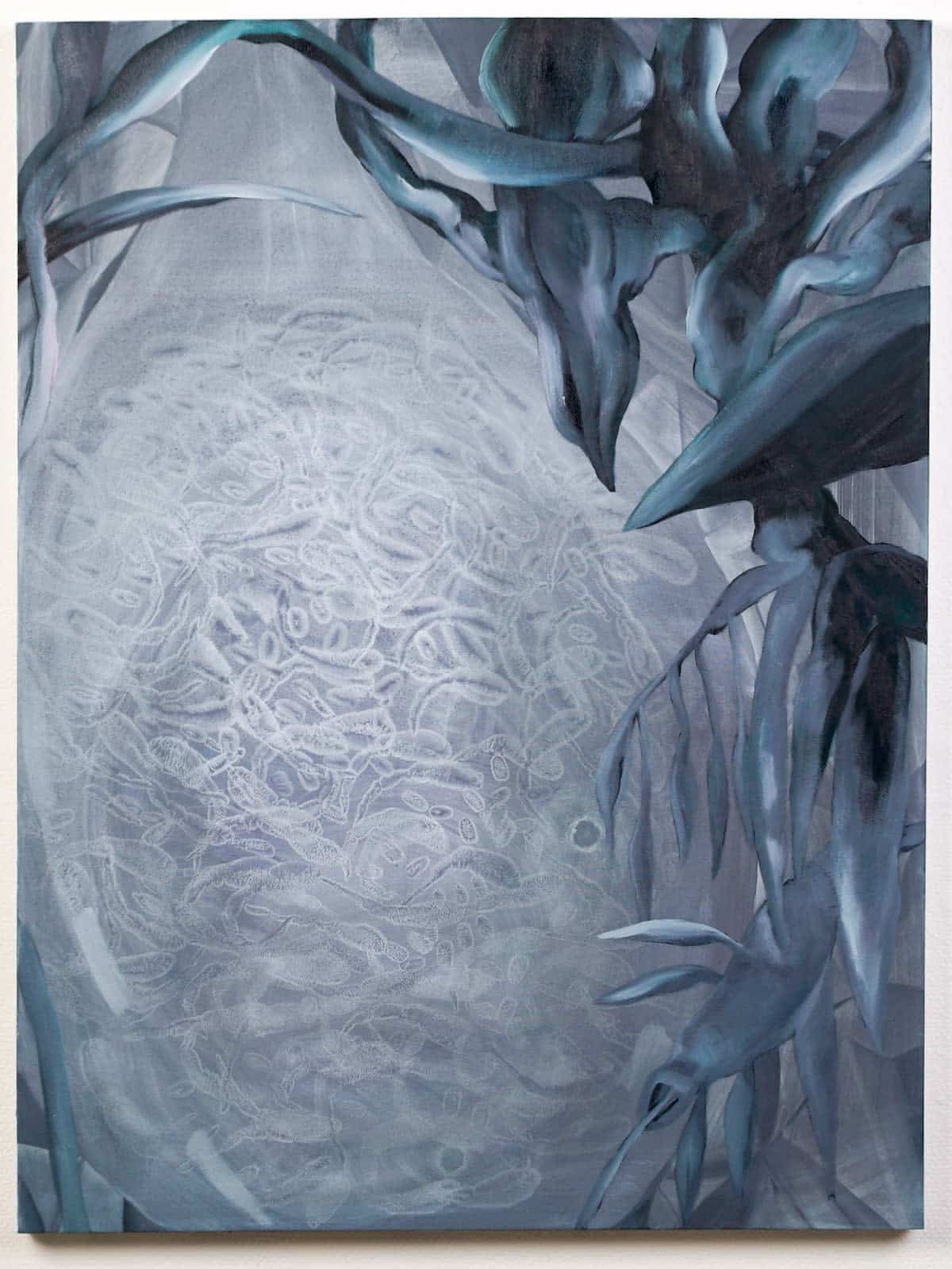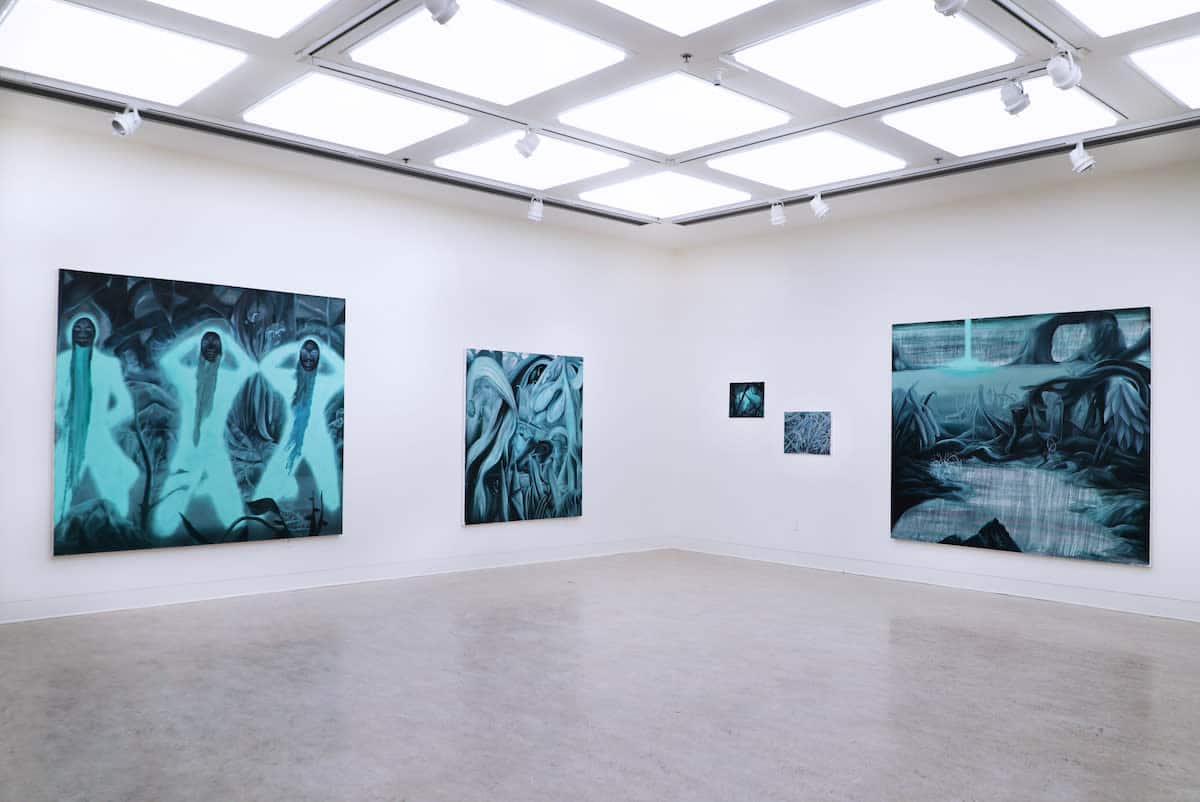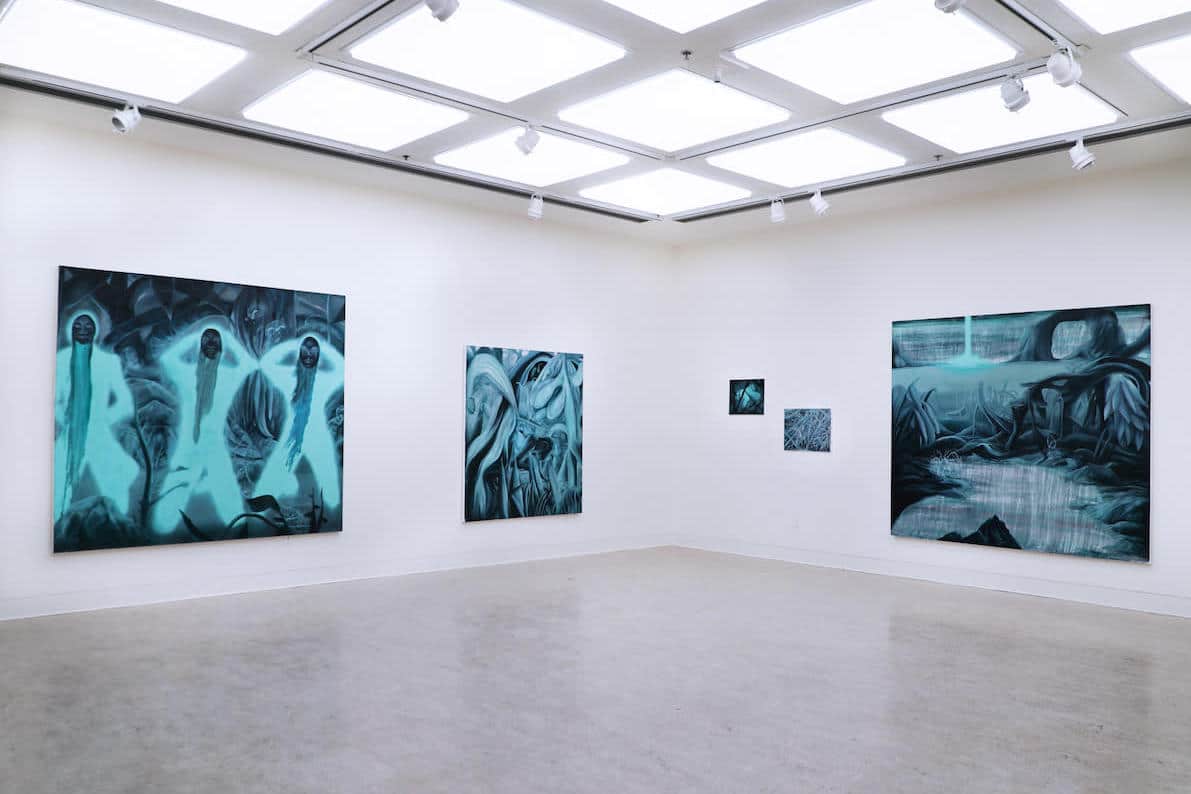Artist Claire Scherzinger creates hypnotic sci-fi paintings which feature fantastical creatures, alien ecosystems, and fictional planets. The Canadian painter, who is currently based in between Seattle, WA and Victoria, BC, recently finished her MFA at the University of Victoria, where she began experimenting with building her landscapes using gaming software. Now, alongside her painting practice, she is developing her ideas into a ten-episode fictional podcast due to be released later this year.
With her eye-catching signature style, Scherzinger favors minimalism and a fresh white background for her artist website, letting the glowing neon blues and greens of her paintings stand out. She showcases her best work online with a streamlined and polished layout with a fixed menu and large, high-resolution images on each page, allowing visitors to easily navigate through her multiple projects while still enjoying the intricate details of her pieces.
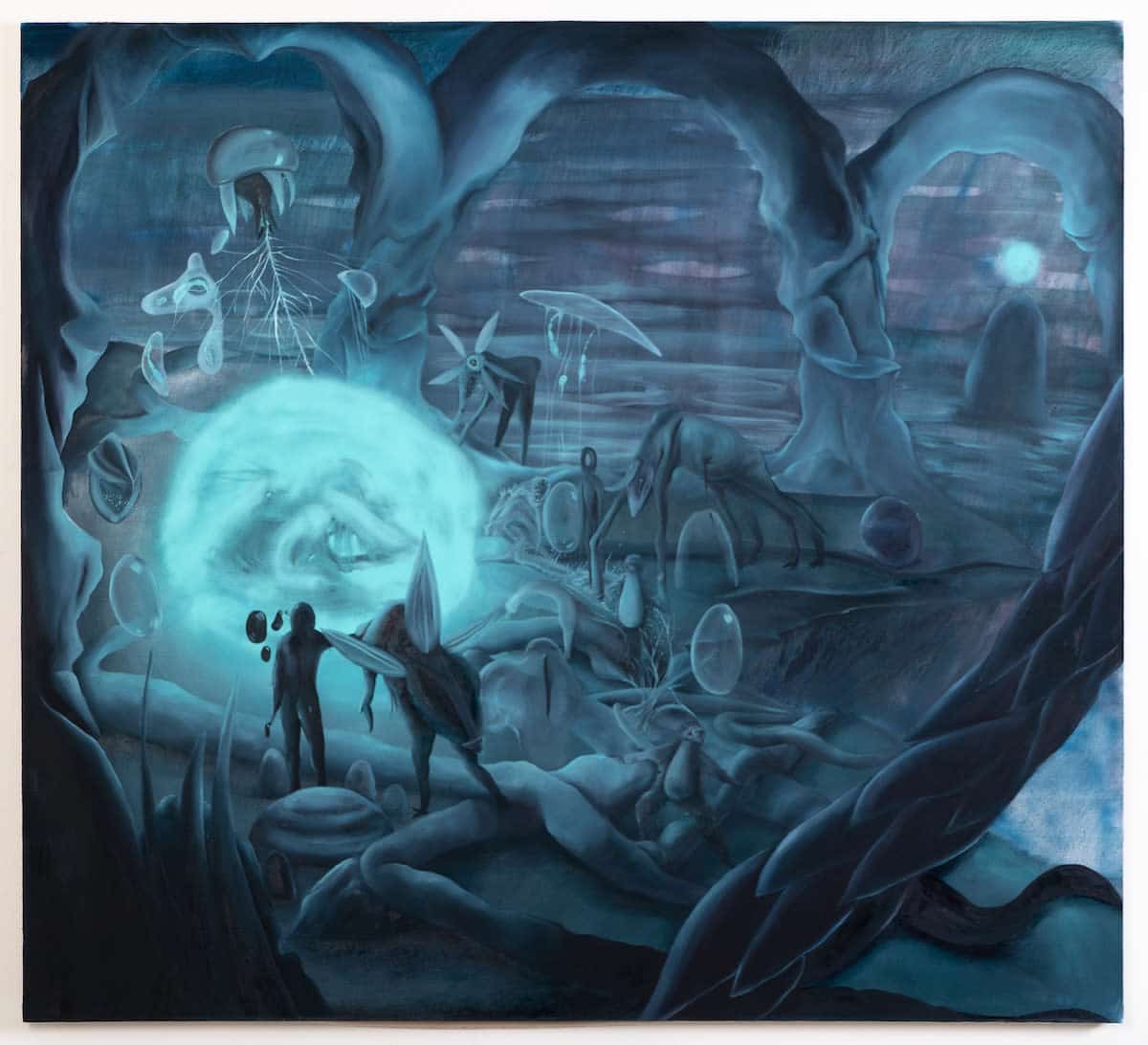
Enticed by her colors and mysterious creatures, we got in touch with the artist to find out more about the inspirations behind her paintings and projects. We learned how her creative and personal life were impacted by a recent trip to Peru and also got her best advice for artists working in the contemporary art world today, as told to her by the guests on her regular podcast Overly Dedicated—yet another of her side projects.
Format Magazine: Hi Claire. First of all, can you describe your work to us in your own words?
I build worlds—virtually, at least. My work in painting and my new burgeoning practice in audio/video centers on an exoplanet I’ve named Arca-45672. Like Tolkien with Middle Earth, Cameron with Avatar, I’ve built my own exoplanet that is full of flora and fauna that I have invented, amounting to a symbiotic ecosystem that is carbon-based. Most of my ideas originate in the form of drawings and paintings, but lately, I’ve been training myself in new media to show other aspects of this world, like the elements of physics and time.
How did you first get into painting?
I was always drawn to fantastical creatures but began drawing obsessively when I was eleven. I started copying manga and comic books with my best friend all the way into 8th grade then got into painting not too long after. I had an art teacher in my hometown who was really great—Katherine Laco. She never imposed how she thought art should be, she just taught me different skills—how to make clay objects, stained glass, painting, drawing. We would sit at her dining room table, drink tea and watch crap daytime TV like Dr. Phil while making things. I think I was 16 approaching 17 when I realized I could do painting as something for which you can get a degree. That was when I became really serious about art. These are all different benchmarks of how I’ve gotten into painting, but even now in some ways, I feel like I’m still getting into it. I’m still realizing the limitations of painting, but also how limitless it can be too.
So you used to be based in Toronto, and now you’ve just finished your Masters at UVic, and I heard on your podcast that you’re moving to Seattle soon. Much of your work features landscapes of some kind—does moving around so frequently affect your compositions?
It absolutely does! I had been thinking about the conceptual drive of my work for some time. In 2015, I was making work that I wasn’t terribly passionate about. However, one of those works won the RBC Painting Competition Purchase Prize, which allowed me to travel to Peru—to the Andes and the Amazon. That trip was so inspiring that I came back to my studio in Toronto and I somehow knew what I wanted to make. I didn’t want to paint the Amazonian jungle since it’s not my home and I was only a visitor, but it inspired me to create a place with unique biodiversity.
That trip to Peru was also where I met my partner. So, I eventually started traveling across the United States to see him, as well as the different national parks. We went to Colorado last year for American Thanksgiving, and the slivers of old, eroded mountains were incredible. Everything I make inevitably comes from a distillation of experiences and places I’ve traveled to and from. However, the core of my work concerning landscapes at this moment revolves around rainforests. Arca-45672 has many jungles, which is why I’ve focused on them in my paintings for a while. This is also where the greatest amount of biodiversity can generally be found, so it is the perfect stage/scenery for telling a story.
Seattle and Victoria have been amazing landscapes to live in while I chew on this content and let it absorb. But I feel a need to mention here that these landscapes are disappearing very quickly due to logging and pipeline construction. I believe less than ten percent of old-growth forests remain.
What drew you to the theme of landscapes?
I’ve been working with Kelly Richardson at UVic for almost two years now, and I think this particular influence comes from her. Before working with Kelly I was making very cartoony vignettes of these scenes, and she helped me move in a direction I had always wanted to go in but wasn’t sure how to get there. Her work concerns hyper-realistic cinematic and immersive experiences in various imagined and real landscapes. (For anyone who likes art and/or movies, look at her work. I think she will be the 21st/22nd Century Yayoi Kusama.)
The landscape is something that is vital in my work because above all I’m weaving a story. The setting and atmosphere will give the viewer the most information—probably more than any of the characters in it. While I do make paintings with characters in them, I want to be able to let the viewer use their imagination to do a lot of the legwork.
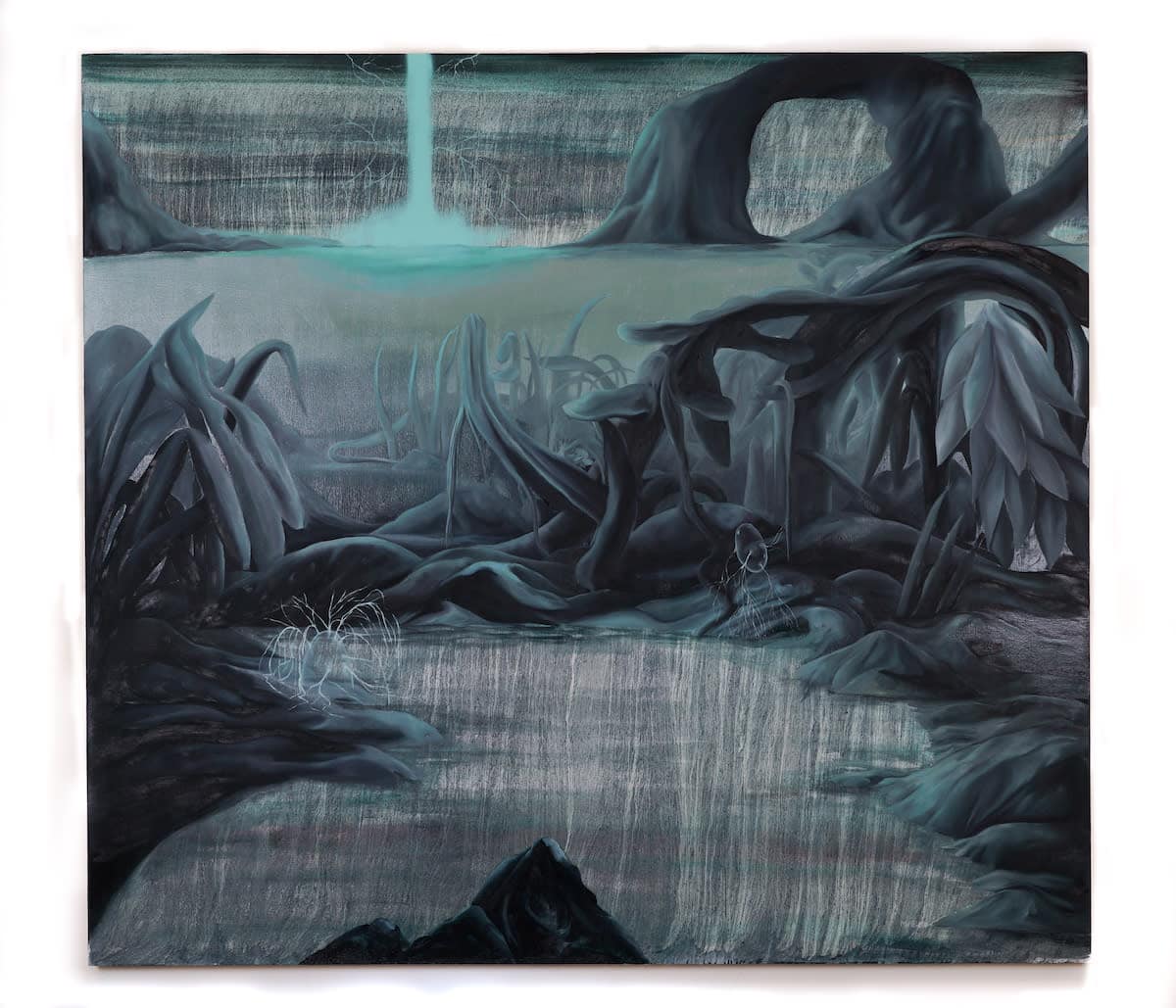
As well as your paintings, you’ve also made ceramics, videos that feature your alien landscapes, and soundscapes of the lifeforms that can be found in them. When did you start crossing over into other mediums?
My crossover into audio/video was recent. I had to really make time to pursue projects I had been mulling over for a while, which ultimately amount to a more cinematic experience of this world. I knew I didn’t have the skills or resources to do the highest quality work I wanted right away, but by using certain mediums that you can pick up quickly, or by collaborating with other people, I could accelerate my learning and make relatively high-quality work. This is the case with the podcast that I’m working on now. I think for a while I had resigned myself to being a painter who makes paintings. But now, I work with lots of different mediums, but still, approach them with the internal logic of a painter.
Any plans for future projects?
I’m really intrigued by technology, and I would love to learn how to use more complex programs and devices as they become more available. I would also love to start building a construct AI. Not an actual real AI, but a kinetic sculptural representation of how we envision the physical form of an AI and why it looks that way. I would also love to find a way to do a project that genetically engineers new kinds of plants. A lot of my ideas are pie in the sky right now, so I’m hoping that further into my career I’ll have more money and notoriety to make it happen. Oh, and I also really want to collaborate with someone to do a comic book one day.
So you are teaching yourself how to construct landscapes in Unreal Engine. Do you find working in a computer program different from your painting process?
There are a lot of differences, but also some similarities. The building process is fairly similar. You’re painting and sculpting landscapes or blocking in the geometry of virtual interiors. Overall I think the two processes complement each other very well. But I’ve always thought that painting and video share a kinship. The way you frame a scene in a painting can be similar to video.
In your podcast Overly Dedicated you talk with other artists about a range of subjects, from physics and neuroscience to music, to more practical topics such as how to navigate the art world. What’s the best piece of advice you’ve heard that you could give to other artists?
Doing this interview series podcast means that I get to talk with so many intelligent and fascinating individuals and even though every one of them has had a different experience with art and the art world, the advice I hear is usually quite similar. “Keep making work,” is a common one. “Make the work only you can make.” It sounds cliché, but at one point they probably got the same piece of advice from someone else—and here they are! It’s all true, and it has value.
You also did a talk recently about professional practice at Emily Carr University of Art and Design. What were the main points that you took away from that experience?
I was by far the youngest person on the panel (I’m 27), so it was interesting to see how others had shaped their careers. Some advice that I gave at this panel talk and would give to younger artists: build your own world. Find the qualities about yourself and your work that make you different from everyone else and expand upon them, in whatever way possible. Build your world with the friends you surround yourself with and make sure that you all keep each other emotionally and mentally healthy.
Your career probably won’t take off until later in life, so keep exercising and stretching. Once you hit 50, you need to be able to make things then, more so than now. Drink water, get enough sleep, eat good food. Go outside. Be seen. Engage with the community.
Keep your word… but also don’t let people walk over you. People in this business take advantage of others in very negative ways. But if you’re honest, and don’t completely compromise your moral compass, then you can build a good name for yourself. The good people will find you and want to work with you because they know you are trustworthy, that your words actually have currency.
The last piece of advice I give to people who are anxious about “making it” is a piece of advice that I got from a mentor when I was in my early twenties. He said, “Claire, you’re honestly just waiting for other people to quit.” Thanks for that one Matt!
There you have it. It’s a marathon. Not a sprint.
Apart from the multiple projects you’re juggling at the moment, what are you working on right now? Any big shows coming up?
I have an exhibition at YYZ, an artist-run center in Toronto in September 2021 and one at the Varley Art Gallery in Markham, ON, which dates are TBA right now. I’m currently working out the logistics for a solo show I was offered in Anchorage, Alaska, for May 2020 and there are a couple of small group shows that are opening this year. One is in LA—that one is organized by Jordan Watts, and then the other is by Claire Battershill and Heather Jessup, which I did a writing/drawing collaboration with Michael Winter. That one will be touring around to various libraries in Canada starting this May.
Aside from the podcast and my paintings, the other big projects I’m about to begin working towards is a feature-length film made in Unreal Engine and Blender. I have no idea where this project will end up, but I’m just going to do it and see what happens. The other project I have on the docket right now is to start bringing together artists and writers who use science fiction in their practice to make a book compilation where the writers will write a short essay/reaction to the artist and the artist will respond.
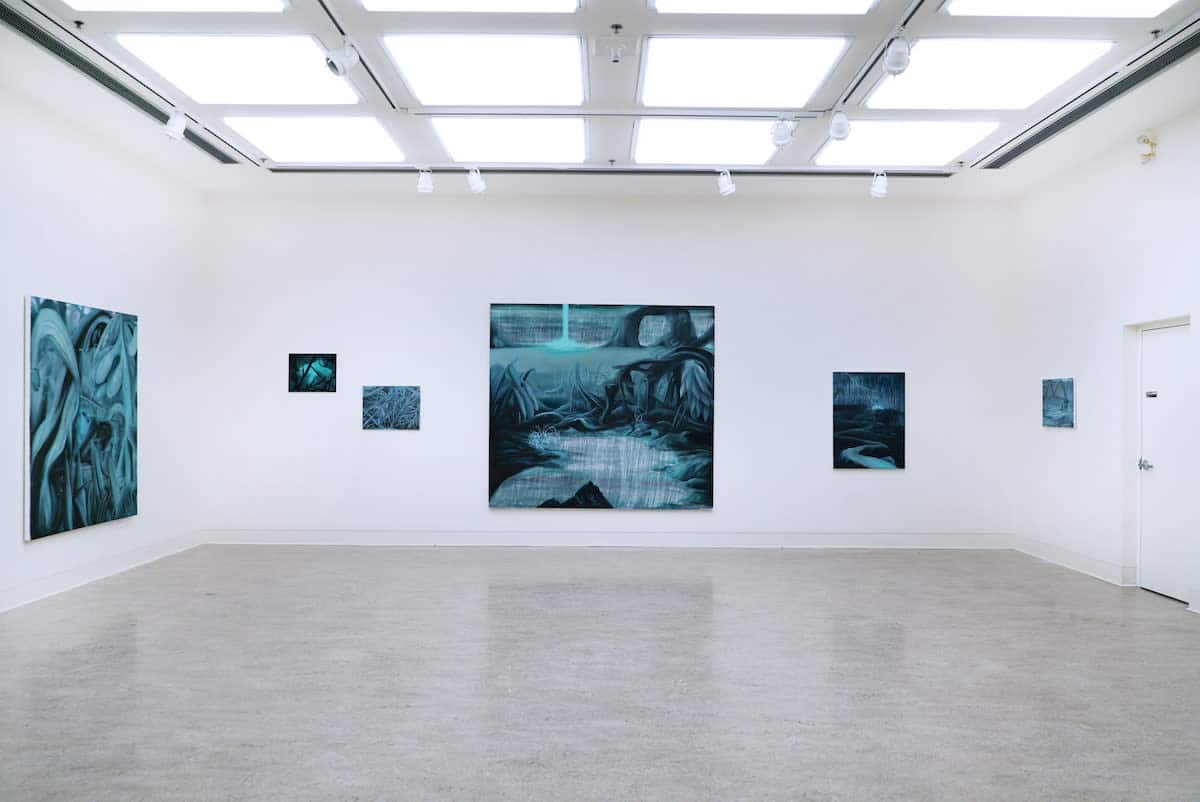
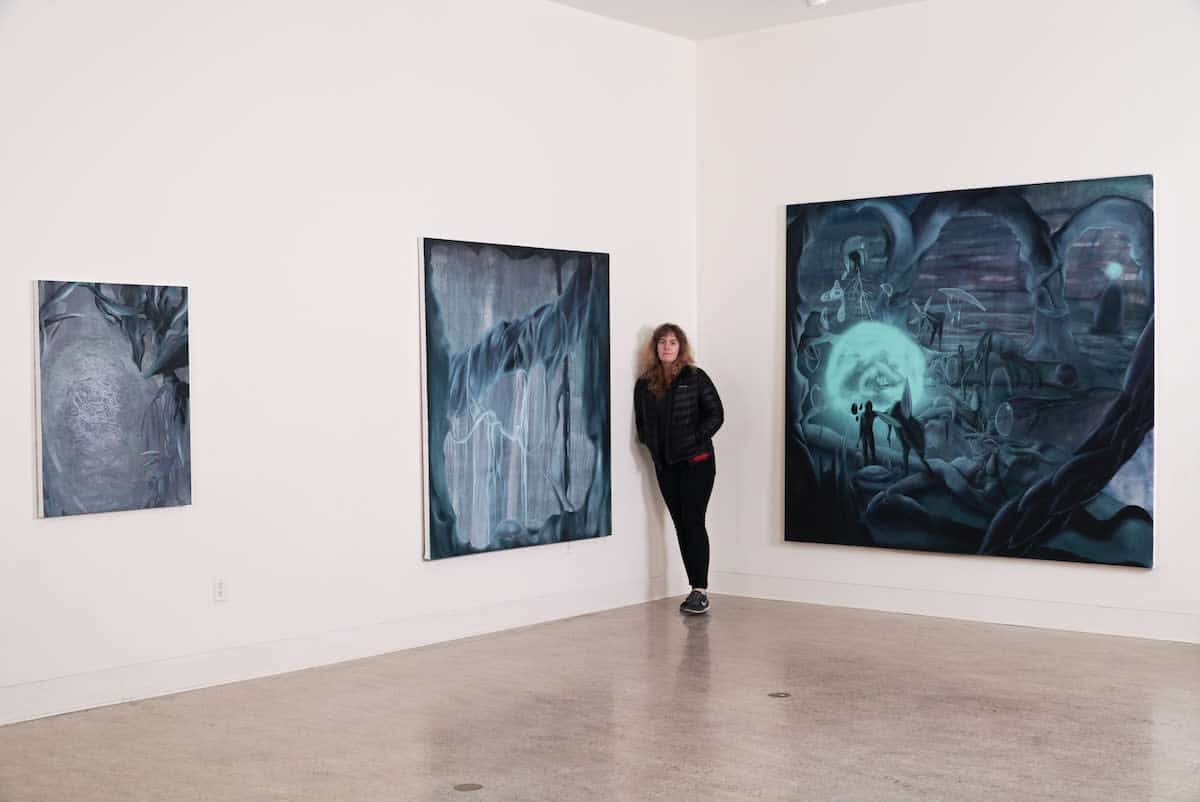
How do you use your website to support your creative work?
Right now my website is the most central portal where you can access all of my finished and upcoming projects. I use Facebook and Instagram, but my website is where you can see very high-quality images of my work, which is paramount for what I do. What I’m trying to figure out now is if I can morph my website into a more experiential portal—could it become an art piece the viewer, or player, has to navigate? Could it tell a story? This is something down the line that I want to try.
And finally, who are your favorite artists/creators right now that other people need to know about?
Here we go, it’s gonna be a smorgasbord. Katja Novitskova, Stephen Appleby-Barr, Jim Holyoak, Rick Leong, Kelly Richardson, Jesse Jacobi, Fastwurms, Octavia Butler, Cixin Liu, Shary Boyle, Louise Erdich, Dominique Fung, Sky Glabush, Chief Lady Bird, Tom Prinsell, Brendan Tang, Lauren Pelc-McArthur, Alex McLeod, Tristram Lansdowne, Luke Painter, Jamiyla Lowe, Jason Stovall.
